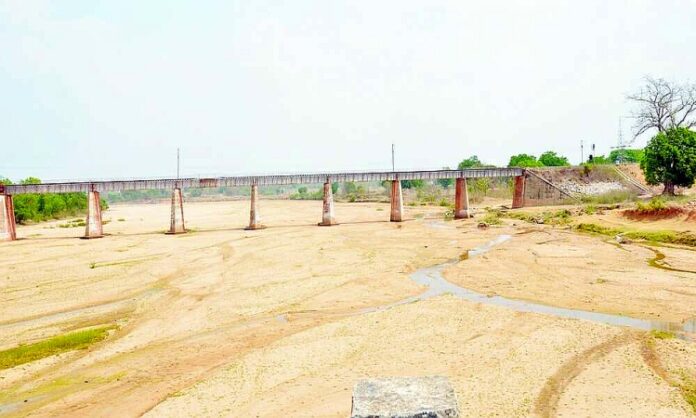Palamu: Once an incessant flowing river and lifeline for Palamu region of Jharkhand, North Koel is battling with its own life. The river, which used to cater to drinking water requirement of about 70% population has gone dry in the midst of summer this year. And this is not a new problem. This is continuing for the last few years, when the river, one of the major river of Gangetic plain runs dry in the peak of summer.
Apart from feeding drinking water to Daltonganj city, the headquarter of Palamu, North Koel had sufficient water to provide irrigation in Jharkhand and Bihar. North Koel irrigation project, envisaging a high-level dam at Kutku village in Latehar district, has been conceived to bring over 1 lakh hectare in the two states under irrigation network.
Also Read: Jharkhand faces forest desertification, state yet to wake up to issues
However, environmentalists fear that entire Palamu region will turn into a desert-like area in the next 50 years of corrective steps were not taken immediately to conserve the river.
More than 50000 population of the district headquarters gets water from this river only. Environmentalist DS Srivastava said that the outbreak of North Koel has occurred from Banari area of Gumla district. There are two artesian wells from which two rivers, North Koel and South Koel emerge. South Koel originates from Gumla and flows through Simdega and joins Mahanadi and falls in the Bay of Bengal.
Also Read: Jharkhand HC questions govt over closure of Kharkai dam project
At the same time, the North Koel originates from Gumla, passes through the forest of Palamu Tiger Reserve (PTR) and joins Sone river via Palamu. This river has many tributaries. It starts from Netarhat. In Netarhat, Pandara Nala, Kohbarwa Nala meet this river. Moving further, the water of Mahuarad Valley mingle with Budha River here. Beyond this, Auranga river meets in Kechiki and Amanat river meets Daltonganj city. After which this river joins the Son River and becomes a part of the Gangetic plain. This river extends for about 265 kilometers in the area of Palamu.
PTR’s forest protects the river
Srivastava said that quantum of water flow in the river is decreasing by the year, but water comes out after slight digging of its sand. Animals, birds and many people use this water. This water comes out only because of forests. During the rainy season, the forests of PTR send water underground. Whereas in the summer season the water is pushed back on ground. The layer of this river is very good in the PTR area. These forests protect this river every year.
Also Read: Longest bridge in Jharkhand on Mayurakshi river opened for traffic
Beyond Kechki, the water of this river dries up completely during the summer season. However, 50 years ago this river used to flow throughout the year. Even during the summer season, wooden bridges were built over the river. But now the river is drying up even before the summer season. The biggest reason for this is deforestation. In the last 50 years, 20% of the forests in this area have been flattened. Due to which this river is drying up. Secondly, due to the rising of sand the temperature is also increasing.
It was further told that sand is being lifted continuously from the river. During the rainy season, due to sand lifting, the soil around the river caved in the river, which gradually starts filling its banks. Regular filling of clay from the banks has made the river shallow. As a result, there will be no water in the river even if water is continuously extracted from the river bed. The layer of sand of the river goes hot and it is belt in the nearby areas of Daltonganj.
Also Read: Jharkhand forest loses 3.53 cr trees, costing ₹822-Cr: CAG to HC
Environmentalists strongly suggest that lifting of sand from the riverbed shall be immediately stopped, which is the only practical wayout to save the river. Along with this, the government needs to plant trees up to 500 meters on both banks of the river under a special scheme. So that a layer of water remains in the river and people do not have to struggle for water.
Palamu area comes under rain shadow
The Palamu region comes under rain shadow. As a result, the region receives less rainfall. Palamu receives a rainfall of 1200 mm. The district administration should completely recharge this water into groundwater under water harvesting. So that rain water can be used. This can save people from water problems to a great extent.
Also Read: Fighting air pollution: Dhanbad Municipal body puts up faux lung
Big crisis for the coming generation
Environmentalists say that drying up of the river is a big crisis for the future generation. Right now people are fighting for land. If not, we will fight for a glass of water in the coming days. If the North Koel River is not protected, the people of Daltonganj city will have to leave the city. The entire Palamu will turn into a desert in the coming 50 years.




